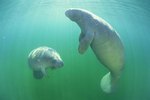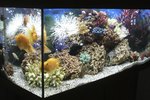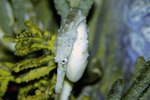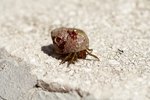
Many marine aquarists keep sea hares (genus Aplysia) because they mow through algae in a hurry. Sea hares are native to temperate and tropical Pacific Ocean waters. Keeping sea hares is only recommended for advanced aquarists -- these animals can release a cloud of toxic ink with the potential to kill an entire aquarium ecosystem.
Water Requirements
Sea hares are highly sensitive to water quality, so the water conditions should be tested regularly. Sea hares cannot tolerate high nitrates or copper. They require a specific gravity between 1.020 and 1.026. A pH between 8.1 and 8.4 with water hardness between 8 and 12 is ideal. Sea hares may live in cool or warm water depending on the species. Cool-water sea hares should be kept between 55 and 60 degrees Fahrenheit, and warm species between 72 and 78. Sea hares are active animals and need the water oxygen content of at least 95 percent. Salinity should be kept between 30 and 36 parts per thousand.
Tank Mates
Introducing a sea hare to an established aquarium in which the other animals are docile is preferable. Sea hares are native to the Indo-Pacific ocean, so they pair well with animals from the same region. Anthias, basslets, batfish, cardinals, clownfish, dwarf angelfish, rabbitfish, gobis, jawfish, squirrelfish, tangs, shrimp, clams, mollusks and wrasse can all coexist with sea hares. Large angelfish, blennies, butterflies, damsels, grunts, pseudochromis, rays, triggerfish, corals and other motile invertebrates can coexist with sea hares with caution. Box fish, eels, file fish, groupers, hawkfish, hogfish, lionfish, puffers and sharks are incompatible with sea hares.
Only one sea hare is recommended per aquarium. Because Aplysia eat so ravenously, introducing more than one can cause a food shortage for its tank mates.
Tank Set-Up
Heavy chemical filtration is required for sea hares. Aplysia are burrowers, so a thick layer of sand for substrate is needed. Sea hares can grow to 12 inches long so require a large aquarium -- at least 75 gallons. Filter intakes and power filter heads should be shielded so the sea hare can't be sucked into them and killed. Covering them with thin mesh such as nylon pantyhose works well.
Because sea hares can grow to be rather large and their stomach foot is strong, they can easily "rearrange" their aquarium. Make sure all decorations and corals are securely anchored.
Feeding
Sea hares eat nothing but algae, and most pet Aplysia species eat specifically hair algae. If your sea hare consumes all the algae in the tank, provide it with dried algae or seaweed to eat until more algae grows. As herbivorous grazers, these animals need a constant food supply. Nori, or dried seaweed sheets, are sold in grocery stores and can satisfy a hungry sea hare until more aquarium algae grows. Because it's difficult to keep a sustaining crop of algae in a home aquarium, many marine aquarists choose to rent Aplysia from pet stores to remove their algae, then return the animal to the store.
If Your Sea Hare Inks
Sea hares may emit a cloud of toxic ink if they're disturbed by you or a tank mate. This toxic substance can kill other animals in your aquarium, so if your sea hare inks you must clean out the ink immediately. Sea hares may also release their toxin when they die, so a deceased animal should also be removed as soon as possible. A high-powered charcoal filter is recommended to help clean up an ink mess quickly. If your sea hare inks, clean the carbon filter as soon as it's done removing the toxin from the water.
References
Resources
Photo Credits
-
Jupiterimages/Photos.com/Getty Images
Writer Bio
Madeline Masters works as a dog walker and professional writer. In the past she has worked as a fitness columnist, fundraising copywriter and news reporter. Masters won two Pennsylvania Newspaper Association Awards in 2009. She graduated from Elizabethtown College with a Bachelor of Arts in English.




